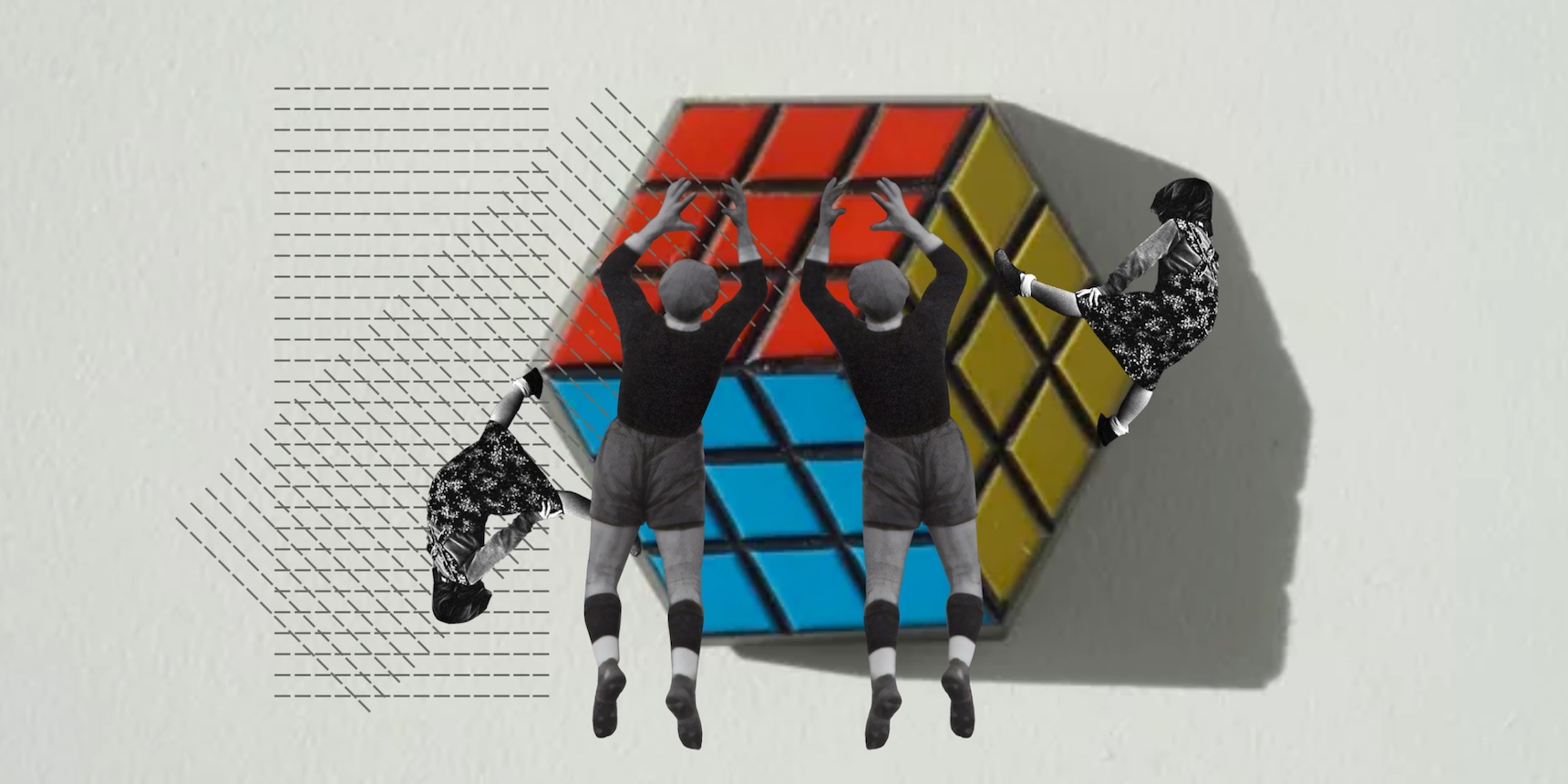
If you are fond of solving puzzles, there is a good chance you have come across the Rubik’s Cube.
In 1974, a young Hungarian professor named Erno Rubik attempted to demonstrate three-dimensional movements to his students. He assembled wood and paper with rubber bands, glue, and paper clips. Eventually, these blocks of cubes became the Magic Cube, today known as the Rubik’s Cube or the 3x3x3 cube.
Initially, Rubik had no idea whether it would be possible to solve the cube. After a month of struggling, however, he finally managed to put it together.
At first glance, the Rubik’s Cube seems simple: it has nine colored squares on each side — red, green, yellow, orange, blue and white. According to mathematicians, there are 43 quintillion (43,252,003,274,489,856,000) potential variations to put these pieces together and only one of these combinations is correct.
Since then, the Rubik’s cube has evolved and different types of cubes have emerged, such as the 4x4x4, 5x5x5, Megaminx, Pyraminx and others. No matter the type of cube you come across, the logic behind solving them is the same: you must learn a sequence of movements that need to be put in a specific order. You start with a shuffled, messy configuration and, by rotating faces or parts, bring each side into a singular pattern of colors.
The Rubik’s Cube has become an entertaining toy and a brain-teasing challenge that tests one’s patience and problem-solving skills. Although it was initially created to teach mathematical concepts, 50 years later, people have turned the cube into a competitive sport called Speedcubing. Participants of these competitions try to complete the puzzle in the shortest amount of time, using the same unscrambled patterns to ensure fairness.
The World Cube Association (WCA) is a worldwide non-profit organization that hosts competitors from over 140 countries. It organizes more than 1,000 speedcubing competitions each year. Its goal is to have “more competitions in more countries with more people and more fun, under fair conditions.” The organization assigns teams, committees and delegates from different countries to organize official competitions worldwide.
Armenia has also become part of the speedcubing world and holds several records on the WCA’s official website. Mayis Jraghatspanyan, speedcuber and the first and only Junior Delegate, recently applied to the WCA to host official competitions in Armenia.
He has been organizing Rubik’s cube competitions in Armenia for three years. As a Junior Delegate, Jraghatspanyan is responsible for making sure that all WCA competitions are run in accordance with the mission and regulations of the organization.
“I was 10 when my mother taught me how to solve the first couple of layers, but she couldn’t remember how to solve the last layer. She told me to use the internet to find out how to solve the last layer,” said Jraghatspanyan. After two weeks of surfing the internet, he solved the Rubik’s cube.
Jraghatspanyan says that learning how to solve the cube helped him become self-disciplined. “All cubers are disciplined, they always have a goal to achieve,” he explains. “I started recording myself and then reviewing the footage to understand what kind of mistakes I was making. Back then, there wasn’t much stuff on the internet about cubing, just a couple of tutorials on how to solve them.”
Most speedcubers learn around 300 algorithms through countless hours of practice. They develop quick pattern recognition skills, memorize those algorithms and put them in their muscle memory. According to research, cubing is generally believed to enhance concentration, memory, reflexes and problem-solving skills.
The Rubik’s Cube has evolved from a classroom teaching tool in Cold War-era Hungary to a worldwide phenomenon, with over 450 million cubes sold and a mini-empire of other cube types emerging. When asked about the most challenging cube he had ever solved, Jraghatspanyan replied, “A four-layer star column cube that took me two months to solve. It was a limited edition, and surprisingly, I found it in a small store in Gavar.” This particular cube is a tough nut to crack because cubers need to learn specific algorithms.
“Every time you scramble it, the resulting position can be different. The odds of having the same position are close to infinite. Every time you try different algorithms and combine these algorithms to solve it, it’s still unique and that is what keeps me interested,” he adds.
There is always the possibility of getting faster at solving the Rubik’s Cube. A couple of years ago, the world record was five seconds. Today it is even less than that. According to Jraghatspanyan, there is always room for improvement.
On June 11, 2023, Max Park set a new world record by solving the 3x3x3 cube in 3.13 seconds at the Pride in Long Beach 2023 WCA competition. The 21-year-old speedcuber from the U.S. holds world records for solving the 4x4x4 cube, 5x5x5 cube, 6x6x6 cube and 7x7x7 cube.
Park is no stranger to breaking records. In the 2020 Netflix documentary, “The Speed Cubers,” Park’s parents shared his story of being diagnosed with autism and how cubing had been therapeutic for him.
Cubing is about skill and speed, but it also involves an element of luck. You can never predict the combination you will get on the last layer. It’s an alternative and intellectually stimulating sport. “It is always a hobby unless you turn it into a profession. You can turn it into a profession and teach people how to solve it,” says Jraghatspanyan.
Jraghatspanyan recalls the time he cubed during his military service. “I remember solving the cube at a store I found in Artsakh,” he recalls. “The entire store watched as I solved it, and then I bought the cube.” Jraghatspanyan had a mission to unite the Armenian cubing community after the Covid-19 pandemic and the 2020 Artsakh War. He believed it was important to allow Armenian cubers to break records on the international stage.
“It took a lot of effort to become a junior delegate,” he says. “I had to serve as a trainee delegate for at least four competitions and I worked with the WCA board. I explained that I had organized every competition in Armenia and had the skills to become a delegate.”
Jraghatspanyan plans to organize more competitions. His next one is at the National Academy of Science on July 13, 2023. He hopes that the Ministry of Education, Science, Culture and Sports will support his competitions, so he can provide necessities and organize them better. “The mission of the WCA is to have more competitions, more people, and more fun. I want to fulfill that mission and bring it to Armenia.”
Kevin Markalian, an Iranian-Armenian speedcuber, has been involved in Armenia’s cubing community for a year and a half. “The best thing for me is networking. Armenian cubers are always ready to talk, share information, and help,” he said, referring to his experience during competitions.
Markalian has been cubing for the past seven years and recently set two new national records for the Islamic Republic of Iran during the Brusov Side Events 2023 competition, which was an official WCA event organized byJraghatspanyan. He broke two records in the Megaminx cube category, which has 50 moving pieces compared to the 3x3x3 traditional cube with 21 moving pieces.
“I have been working on that one for years,” he said, referring to his recent record. “I remember solving it in 50 seconds in my room during the pandemic and since then, I have been waiting to make it official during a competition. I wasn’t able to do it in Iran, so it was a big deal to do it here in Armenia.”
Cubing trains the creative side of your brain because you are constantly thinking about the fastest way to solve the puzzle. According to Markalian, “curious people thrive way better in cubing because they always ask questions like ‘What if I had done this move instead of this one?’ They start to learn other algorithms and begin to experiment. I was one of those people.”
He adds that there is always room for improvement and that cubing has helped his intelligence and mental health. By the end of ninth grade, Markalian was at the top of his class.
The speedcuber confessed that the challenge of getting good at it is the time-consuming practice. To get half a second faster, it takes 10,000 solves.
At the Georgia Open 2023 competition, Eduard Hakobyan set a national record of 5.40 seconds in the Pyraminx category. The 13-year-old has been cubing for the past two years. He began by solving the Rubik’s Cube in four minutes and can now solve it in about 13 seconds. “For me, this is more fun than playing on the phone. It was difficult at first, but it became easier after I learned the algorithms,” Hakobyan shared.
When trying to solve a cube, it’s important to break it down into steps, Hakobyan advised. “Start with the 3x3x3 cube. It has all the basic concepts and algorithms necessary for the other puzzles. The key is to practice and not give up.”
There are numerous resources around cube-solving, including hundreds of YouTube tutorials, speed-solving strategy books, articles and a number of online communities dedicated to the cube. Since its invention, people have set records for solving the cube underwater, while skydiving, blindfolded and even while juggling. Whether considered a toy, a pastime, a learning tool, or a workout for the brain, solving a Rubik’s Cube and putting the colors back together again seems to provide a sense of accomplishment.
Discovering Armenia: The Potential of Archeological Sites and Obstacles to Excavations
Today, there are ongoing excavations of archaeological sites throughout Armenia, including the excavation at the site of the ancient Armenian capital of Dvin. Despite the country’s huge archeological potential, specialists in the field often face numerous barriers.
Read moreArmenian Film Music: A Culture That Disappeared
The majority of the music we hear in contemporary Armenian films and TV-series are simply plucked from the Internet with little regard for copyright issues, professionalism or the suitability of the tracks.
Read moreSerapian: The Milanese Secret
How a young boy went from selling his hand-stitched leather goods out of a suitcase to building one of Italy’s most exclusive brands.
Read moreThe Eternal Magic of Mariam Petrosyan’s Gray House
Translated into several languages, Mariam Petrosyan’s epic novel “The Gray House” has enchanted readers across the world. In this first book review, Lilit Margaryan speaks with the elusive Petrosyan about her life and the life of a novel that took 18 years to write.
Read moreKond: A City Within a City
A tucked away city within a city, the district of Kond in Yerevan has a rich history and a promising future only if authorities undertake a large-scale restoration. What are the stories of Kond and what does the future hold for one of the oldest quarters in the country’s capital?
Read moreThe Sculptor of Death Masks
Born in Gyumri in the late 19th century, Sergey Merkurov is considered the greatest Soviet master of death masks. He was highly sought after to take the death masks of various Soviet luminaries and leaders, as well as prominent cultural figures of the era.
Read more







Very informative, interesting and well written article. Good job on your research ????
Thank you for article. It is useful for those who study mathematics to know that the mathematics of the Rubik’s Cube is based on graph theory, group theory, computability theory and combinatorics.